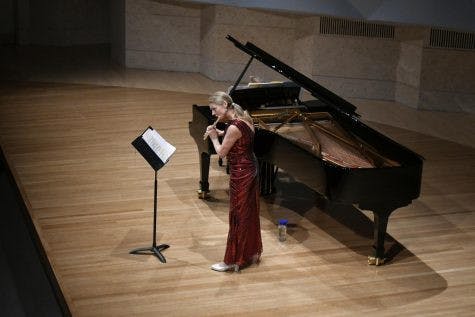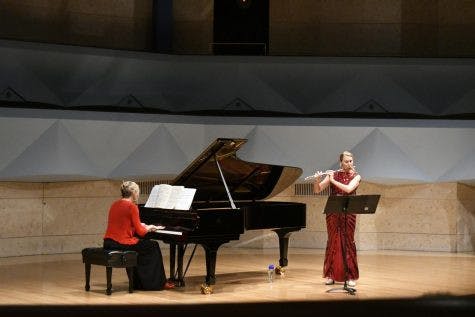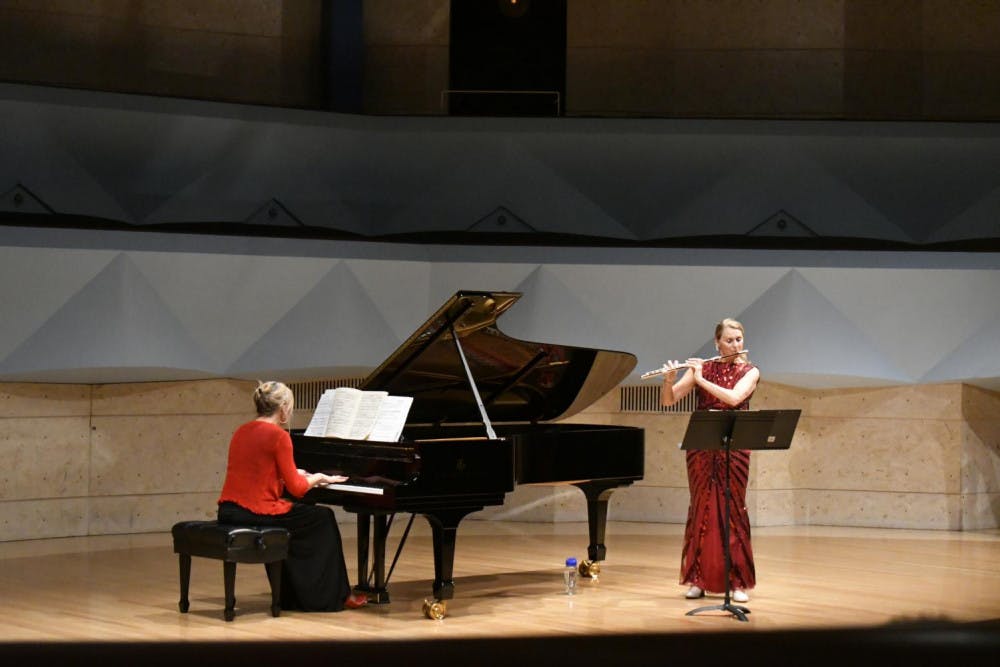On Valentine's Day, the Middlebury College Department of Music hosted a faculty recital in Robison Hall. The concert included flute ensemble pieces from Sergie Prokofiev (1891-1953), Robert Schumann (1810-1856) and Claude Debussy (1862-1918). Flutist Anne Janson shared the stage with three other Middlebury Affiliate Artists: pianist Annemieke McLane, violist Stefanie Taylor and harpist Rebecca Kauffman.
The evening began with Prokofiev’s “Flute Sonata in D, op. 94” (1943). Prokofiev, a Ukrainian composer, wrote the piece during one of the bleakest periods of the USSR’s involvement in the Second World War, several months after the Battle of Stalingrad.
I sometimes have misgivings about Prokofiev’s style. To me, Dmitri Shostakovich (1906-1975) and Aram Khachaturian (1903-1978) are the best of the Soviet composers. Those two artists used their compositions not just to enchant audiences, but to simultaneously decry the horrors of Stalinism. Although the USSR once denounced Prokofiev’s early music as “anti-democratic formalism,” his music generally lacks the overwhelming political and artistic boldness of Shostakovich or Khachaturian. With the exception of the Montague theme from “Romeo and Juliet,” Prokofiev wrote only a few truly hummable tunes.
But Janson’s playing won me over. She deftly tapped into the piece’s darkness, playing minor, occasionally discordant melodies. The piano sections told a jazzy narrative, while the flute playing harkened a military march. The lines between key signatures often blurred.
Janson’s favorite piece of the night was the Prokofiev. “The Prokofiev Sonata goes back the farthest with me and I have performed it many more times than any of the other pieces,” said the flutist. “What I love about it is the dignified and respectful writing for the flute. Most sonatas of this size were written for instruments like the piano or violin.”

“[‘Sonata in D’] is a hard piece to pull off,” Janson said. “It’s tiring and easy to play it out of tune, jumping up and down throughout the registers. It’s technically challenging, and after all of that, the main goal is to hopefully give a good musical performance in honor of the composer.”
Janson’s performance honored Prokofiev, and then some. Her interpretation of the third “Andante” movement was particularly nice; hurtling through arpeggios, Janson reached some tricky sounding high notes that stood out from the low frequencies of McLane’s piano playing.
“Playing soft is very hard to do, the tone can get thin and flat,” said Janson. “Fortunately I love the soft effect and so I stay in shape to do so — I play long tones every day very softly with a tuner.”
The last movement of the Prokofiev was the most energetic part of “Sonata in D.” McLane was able to pull off some Rachmaninov-esque piano chords that resounded far into the balcony, while Janson kept the tempo alive with quick glissandos.
[pullquote speaker="Anne Janson" photo="" align="center" background="on" border="all" shadow="on"]The main goal is to hopefully give a good musical performance in honor of the composer.[/pullquote]
For audience members who found the Prokofiev piece to be a little too wild, though, there was much to enjoy in the evening’s next segment: “Three Romances, op. 94” (1849) by Robert Schumann.
Schumann’s compositions are, in some ways, the most emotionally touching of the mid-1800s musical canon. His music has all the tenderness of Chopin or Schubert, but is laced with Mendelssohn’s subtlety. Considering Schumann’s personal life adds layers to his music, too. An 1854 suicide attempt and subsequent confinement in a mental asylum cast large shadows over the composer’s work.
My favorite selection of the “Three Romances” was “Einfach, innig” (“simple, heartfelt”). Janson played the section softly, creating a contrast with the brasher Prokofiev piece she had played minutes before. Of particular interest was how the nostalgic motifs of “Einfach, innig” invoked Schumann’s “Scenes from Childhood” piano vignettes. Coming into the recital, I certainly knew that I would enjoy the Schumann piece, but I didn’t expect to be as moved as I was.
After a brief intermission, Janson — now joined by violist Stefanie Taylor and harpist Rebecca Kauffman — interpreted three brief pieces by University of Vermont music teacher David Fuerzeig, “Short Songs for flute, viola and harp” (2019). These compositions were lovely, paying homage to Debussy while sounding reasonably original.

The Debussy “Sonata for flute, viola and harp” (1915) stole the show. The finest part of the sonata was the opening “Pastorale” segment, where Kauffman’s harp-playing hinted at the impressionist fad of Japonisme. Throughout the sonata, the musicians illustrated the pentatonic scales and warbling trills that Debussy used to break away from the Romantics. In the “Interlude” section, for instance, Taylor’s viola went up and down zig-zaggy scales in a typically impressionist motif.
A rookie mistake when playing impressionist music is to emote, to “feel” the music and let dynamics and phrasing go on a weekend vacation to Liberaceland. You can sometimes get away with this when playing the Romantics. I, for instance, occasionally add a little too much spice to Chopin’s waltzes. But that sort of behavior does not fly with the likes of Ravel and Debussy. Like a Monet landscape, a Debussy piece strings together an accumulation of elements, adding up in a final image that dwarfs the sum of its parts.
The performers kept Debussy’s music crisp. Janson’s team — especially Taylor — let no individual motif stretch out too long, and the dynamic transitions emphasized neatness. When the final notes of the sonata died away, the audience was uproarious.
The Middlebury Affiliate Artists who performed last Friday didn’t just command three difficult compositions: their heartfelt musicianship was also a good antidote to a cold Vermont evening. On my way out of the Mahaney Center, I stopped at a practice room and plunked my way through Debussy’s “Clair de Lune” — a song which I find myself playing when I’m happiest.
Debussy: Antidote to a cold Vermont Valentine's

MAX PADILLA/THE MIDDLEBURY CAMPUS
MAX PADILLA/THE MIDDLEBURY CAMPUS
Comments



